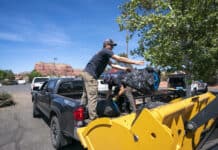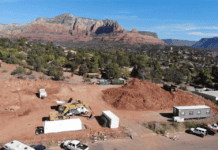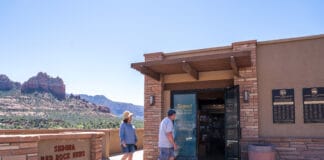What do John Wayne, Elvis Presley, Henry Fonda, Jimmy Stewart and Humphrey Bogart have in common — aside from being some of the most famous entertainers in history?
They all filmed movies in Sedona. At one time Sedona was a hotbed for movie-making as dozens of films, mostly Westerns, were shot in and around the area.
But as more and more people moved to Sedona, and it became a popular tourist destination, the number of films dropped dramatically. Today, Sedona is host to the occasional commercial, music video, reality show or feature film.
Janeen Trevillyan, the president of the Sedona Heritage Museum, spoke to a packed house at the Church of the Nazarene on April 23. She spoke as part of the ongoing guest speaker series presented by the Sedona Public Library. Her discussion was titled the Golden Era and Movie Making in Sedona.
“It’s been 95 years since the first movie was made in Sedona, and since then there were more than 100 movies made in the area,” Trevillyan said.
From the early 1940s to the early 1960s, she said every major film studio had Sedona on its radar for its natural beauty and Western-looking scenery. And while the movie industry appreciated Sedona, the 400 to 800 residents of the area in that time appreciated them as well. Many locals got jobs as extras or behind the scenes with carpentry work, security and catering.
“It all started with [author] Zane Grey, who came here in 1918 where he wrote his book ‘Call of the Canyon,’” Trevillyan said. “In 1923 he came back with a film crew to make a silent film version of that book. He had creative control, and because of that he said he wanted to make films where they were actually set, not on some back lot in Hollywood.”
The original copy of that film was lost with only 29 seconds of it found, which can be seen on YouTube. That portion shows a brief stagecoach ride along what’s now the switchbacks in Oak Creek Canyon.
As the movie industry began to grow in Sedona, so did the need for accommodations and places to eat for the cast and crew. A hotel, dining hall and sound stage were built and were used for years for various movies including John Wayne’s “Angel and the Badman,” which was filmed here in 1946.
“Now, all these movie crews could take advantage of these amenities,” Trevillyan said. “When a movie came to town, everyone would go down to the set because it meant cash. The movies contributed greatly to the local economy.The crew and stars would patronize the local restaurants and bars and would pay to stay in people’s homes.”
The telegraph office seen in “Angel and the Badman” was found just a few years ago, moved from the Red Rock Loop Road area, restored and can now be seen at the Sedona Heritage Museum.
While many worked behind the scenes, she told of how some residents would get to be extras in the Old West movies and that in one scene they would be upon a black or brown horse as a cowboy and in the next scene they were spray-painted brown, given a loin cloth, a different colored horse and would now be an American Indian. The film was then edited together to form a chase scene.
Trevillyan gave her short list of favorite movies in which areas of Sedona are on prominent display. Those include:
- “Broken Arrow,” 1949, starring Jimmy Stewart
- “Last Wagon,” 1956, starring Richard Widmark
- “The Rounders,” 1965, starring Henry Fonda
- “Stay Away Jack,” 1968, starring Elvis Presley
Trevillyan said of the movies filmed here, the location was almost always somewhere other than Sedona. The area substituted for Oregon, Missouri, Utah, California and once the Canadian Rockies. In fact for the latter movie, pine trees were cut in the forest, brought to the location and replanted for one scene in which Royal Canadian Mounted Police rode by on horseback.
“Sedona was a very popular place to film movies, especially after World War II,” she said. “Between 1945 and 1950, 19 movies were made in Sedona — on average two to three a year. By contrast, just 18 movies were filmed here in all of the 1950s. At that point, you could see the writing on the wall.”
By 1960 the Western movie genre was losing much of its popularity and thus, fewer and fewer movies were being filmed locally.
Along the way, Sedona’s population was increasing, so roofs were impeding upon the unobstructed vista views that were coveted by filmmakers just a decade earlier.
Ron Eland can be reached at 282-7795 ext. 122 or email reland@larsonnewspapers.com


















